You’re drawn to a golden glow because cultural standards associate tanned skin with health, wealth, and vibrancy, reinforced by media and celebrity influences. Social norms make you believe that a tan boosts confidence and attractiveness, often driven by the desire to match beauty ideals. Many use tanning to feel better about themselves, but it comes with health risks like skin cancer and aging. To uncover more about why you love that sun-kissed look, keep exploring these fascinating psychological and social factors.
Key Takeaways
- Cultural and media influences shape the perception that a tan signifies health, attractiveness, and vitality.
- Social norms and peer behaviors reinforce tanning as a way to boost confidence and social appeal.
- Tanning is linked to internalized beauty standards, making individuals associate it with increased self-esteem and positive self-image.
- The desire for a “golden glow” is driven by celebrity and influencer endorsements, normalizing tanning as desirable.
- Psychological benefits, such as improved mood and perceived attractiveness, motivate tanning despite known health risks.
Cultural Beauty Standards and the Tan Ideal

Cultural beauty standards greatly influence the popularity of tanning, shaping what societies consider attractive. In the early 20th century, tanning shifted from a sign of hard outdoor labor to a symbol of wealth and leisure. Coco Chanel’s influence in the 1920s helped cement tanning as a beauty ideal. Over time, attitudes toward skin color changed, transforming tanning from a mark of poverty to a status symbol. In Western cultures, a tan is often linked to health, vitality, and enjoyment, while Eastern societies traditionally favor fair skin as a sign of elegance and social standing. These differing standards reflect broader cultural values and historical contexts, highlighting how perceptions of beauty evolve with societal changes and economic factors. Your view of beauty is deeply shaped by these cultural standards. Additionally, advances in cosmetic and skincare technology have contributed to shifting perceptions of the perfect skin tone, allowing individuals to achieve desired looks without sun exposure. Moreover, modern sunless tanning methods provide safer options that align with contemporary health concerns and beauty ideals. The development of innovative tanning products has also made it easier to attain a consistent, natural-looking glow, further influencing beauty trends.
How Social Influences Shape Tanning Behaviors
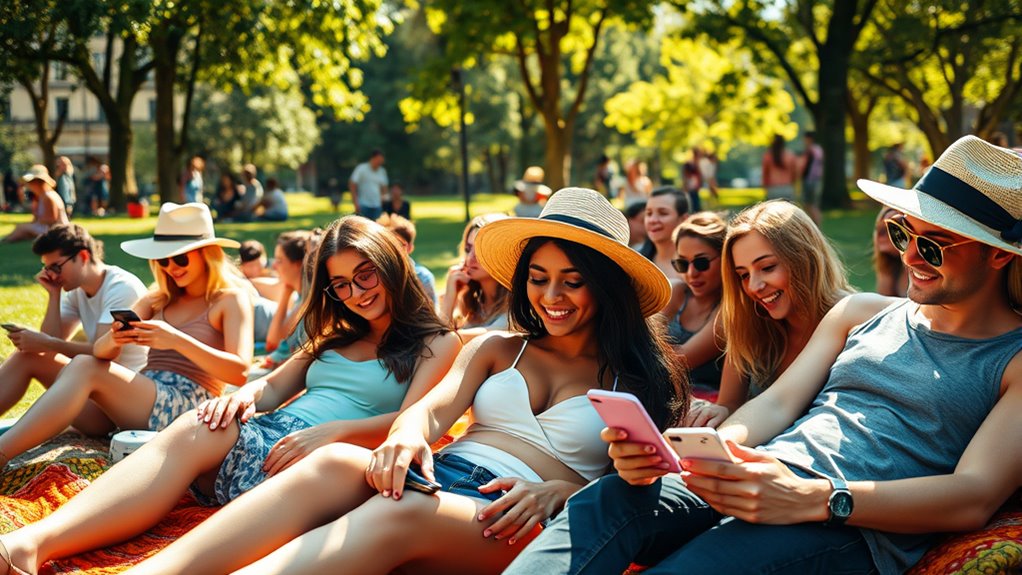
Social influences play a powerful role in shaping tanning behaviors, especially among young women. Social media exposes you to curated images that promote tanned beauty ideals, making indoor tanning seem fashionable. Likes, shares, and comments from peers reinforce the norm, while influencer endorsements subtly normalize tanning as desirable. Interactive features like filters and hashtags amplify exposure to pro-tanning messages, with algorithms prioritizing appearance-focused content. Peer approval considerably impacts your tanning choices, as friends’ compliments and modeling behaviors encourage you to adopt similar habits. Group activities like pre-event tanning sessions further normalize frequent use. Parental attitudes also matter—if your parents, especially your mother, tan regularly or view tans as attractive, you’re more likely to follow suit. All these social cues shape your tanning behaviors deeply. Additionally, media portrayals often associate a healthy glow with attractiveness, further reinforcing the desire for a golden tan. Moreover, the societal idealization of a bronzed appearance can intensify the motivation to seek a tanned look. Interestingly, research indicates that peer influence can significantly sway individuals toward tanning, especially when role models or friends demonstrate positive attitudes toward it. Furthermore, the aesthetic appeal of wall organization and home decor can also subtly influence personal grooming and self-care routines, including tanning habits. Recognizing these social factors can help you understand how your environment influences your choices and perceptions related to tanning.
Perceptions of Health and Attractiveness in Tanning
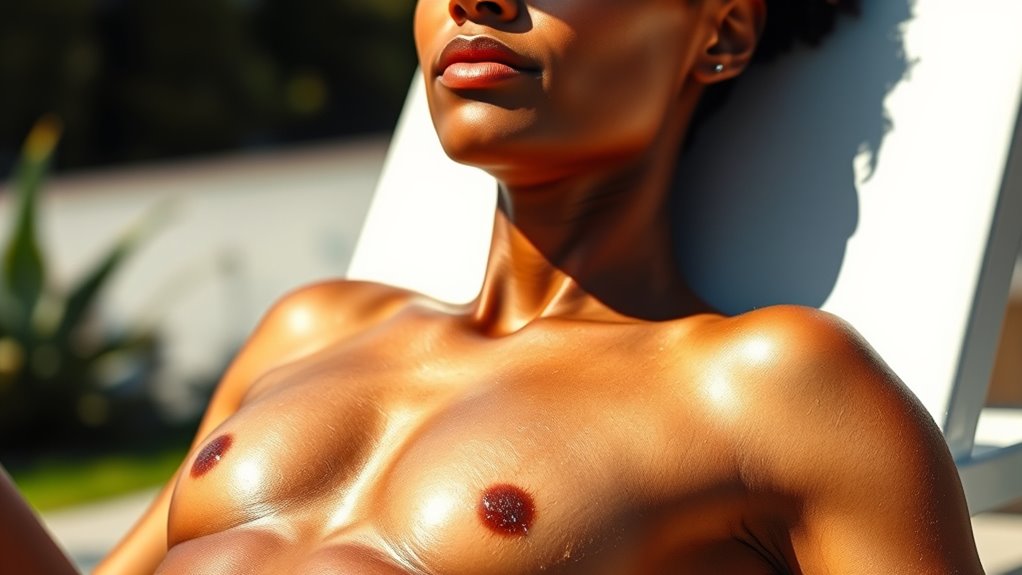
Many people believe that a tan makes them look healthier and more attractive, even though this perception is shaped by media and societal standards. In many Western cultures, a tan skin tone is associated with vitality, youth, and beauty, making it seem more appealing. You might think a bronzed glow signals good health, despite knowing the health risks involved. Media images of celebrities and models reinforce this idea, showing tanned skin as the ideal standard of attractiveness. Evolutionary theories suggest that a tan could signal fertility and well-being, further boosting its desirability. Cultural norms and social influences shape your perception, encouraging tanning as a way to enhance your appearance and fit societal standards of beauty, often overriding concerns about health risks. Additionally, the influence of Coffee Culture and social environments can also play a role in shaping perceptions of attractiveness and health behaviors.
The Role of Self-Perceived Attractiveness and Confidence
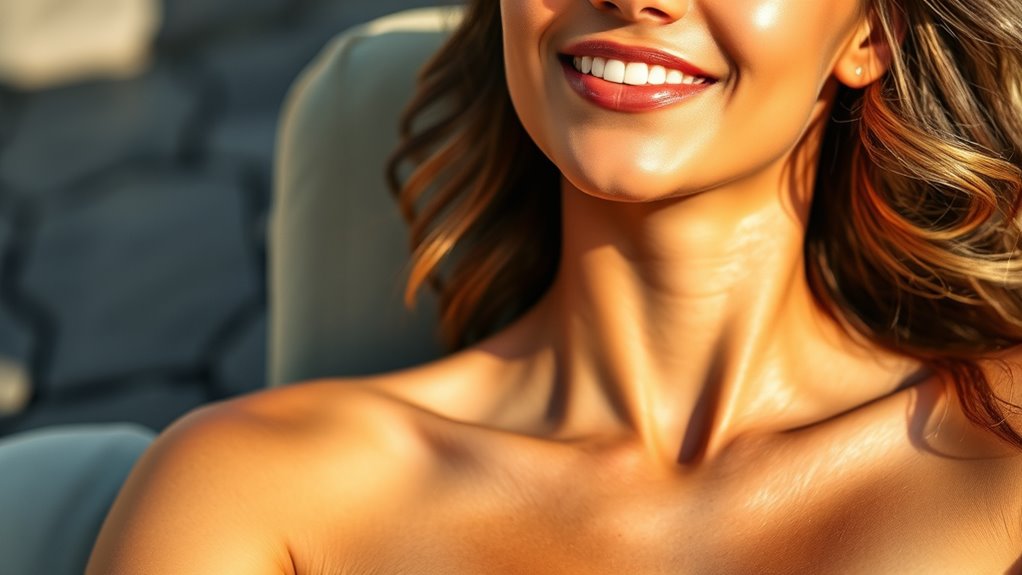
Your perception of how a tan influences your attractiveness can considerably boost your self-confidence. About 89.3% of tanning bed users report feeling more confident with a tan, linking tanning directly to higher self-esteem. Nearly 93% believe they look better when tanned, showing a strong connection between tanning and perceived attractiveness. Many use tanning to prepare for social events, like weddings or parties, boosting their social confidence. Women in social groups, such as sororities, often tan more to enhance their appearance and self-assurance. Tanning becomes a strategic move to meet cultural beauty standards, driven by internalized ideals and peer influence. This desire for a confident, attractive appearance often outweighs health concerns, making tanning a key tool for self-perception and social success. Additionally, the self-perceived attractiveness associated with a tan can influence interpersonal interactions and overall social dynamics. Research also indicates that cultural beauty standards strongly shape individuals’ tanning behaviors, reinforcing the importance of appearance in social settings. Furthermore, the psychological benefits of tanning can reinforce positive self-image and social approval. Understanding the role of personality traits can help explain why some individuals are more influenced by societal beauty norms and seek tanning as a means to enhance their social standing.
Psychological Factors Behind Tanning Motivations
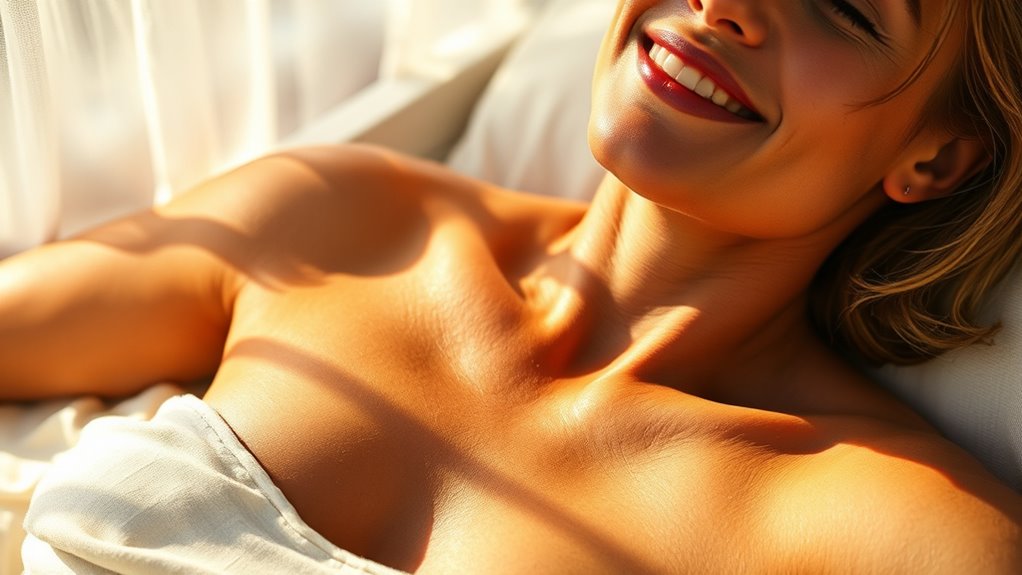
Psychological factors play a significant role in why people choose to tan, often driven by deeply rooted beliefs and emotional needs. Social influences, like peers, media, and societal standards, shape perceptions of attractiveness and encourage tanning as a way to fit in. If you’re focused on your appearance, tanning may seem like a quick way to boost confidence and feel better about yourself. Emotional benefits, such as feeling happier or more confident, also motivate tanning, especially for those experiencing depression or low self-esteem. Some individuals with mild obsessive traits continue tanning despite health risks, perceiving aesthetic gains as outweighing dangers. Additionally, the desire for a golden glow can be reinforced by cultural norms that associate tanned skin with health and vitality. This connection is often supported by vibrational alignment, where individuals subconsciously attract outcomes that match their emotional states and beliefs. Furthermore, body image perception influences the extent to which individuals pursue tanning as a means of achieving societal ideals. Engaging in positive self-image practices can help reduce the compulsion to seek external validation through tanning. Ultimately, the desire to make positive impressions and be part of a social group fuels tanning behaviors rooted in psychological needs and cultural norms.
Risks and Health Consequences of Tanning Practices

Tanning poses serious health risks that shouldn’t be overlooked, as exposing skin and eyes to UV radiation can lead to life-threatening conditions. Indoor tanning before age 35 increases melanoma risk by 75%. UV exposure causes DNA damage, raising the chance of basal cell carcinoma, squamous cell carcinoma, and melanoma. A single blistering sunburn in childhood or adolescence nearly doubles your melanoma risk later. Tanning accelerates skin aging, causing wrinkles, age spots, and loss of firmness by damaging collagen and elastin. It also harms your eyes, increasing the risk of ocular melanoma, cataracts, and other degenerative diseases. UV radiation weakens your immune response, reducing your body’s ability to repair skin damage and fight cancerous cells. Repeated tanning, whether indoor or outdoor, adds up, leading to long-term health consequences. Additionally, AI-powered skin analysis is emerging as a tool to help individuals assess their skin health and risks associated with UV exposure. Recent advancements in AI-driven health monitoring may further improve early detection and prevention strategies for skin cancers. Moreover, understanding the benefits of glycolic acid can play a role in skin rejuvenation and protection against environmental damage. Furthermore, research indicates that genetic predispositions can influence individual susceptibility to skin cancers and UV damage, emphasizing the importance of personalized sun safety measures. It is also important to recognize that proper skin care routines can help mitigate some of the environmental damage caused by UV exposure.
The Impact of Media and Celebrity Influence

Media and celebrity portrayals markedly shape attitudes toward tanning by consistently presenting it as a desirable beauty standard. TV shows, magazines, and social media often depict tanned skin as attractive, rewarding it with social approval and admiration. Celebrities and influencers serve as role models, inspiring young women to emulate their glowing complexions. These depictions link tanning with enhanced attractiveness, mood, and even health—despite the risks involved. Social media amplifies this influence by enabling users to share tanning experiences and images, fostering peer validation. Influencers and celebrities promote tanning products and services, blurring awareness of health dangers while increasing the desire to achieve similar looks. This constant exposure reinforces tanning as a key element of beauty, making it harder to resist the cultural push toward a golden glow. Additionally, the portrayal of tanned skin in media often reinforces cultural beauty ideals, influencing societal standards and individual choices.
Sociocultural Variability in Tanning Norms
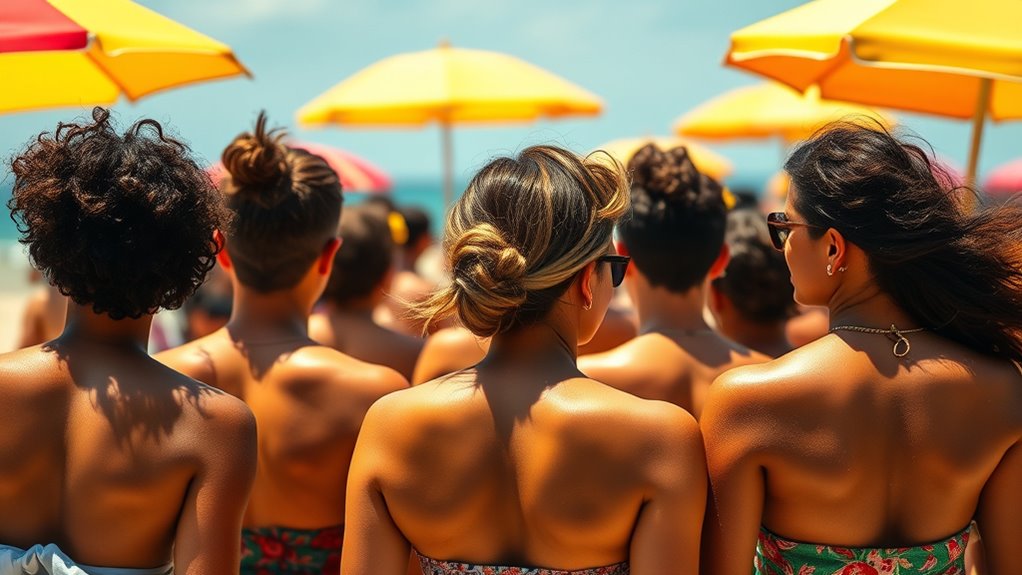
Cultural beliefs and historical contexts heavily influence how societies perceive and value skin tone. In Western cultures, especially in North America and Europe, a tanned skin became a symbol of health, vitality, and leisure in the early 20th century, often linked to wealth and privilege. Conversely, many Asian cultures have long prized fair skin, viewing it as an indicator of beauty and social status, rooted in ancient traditions. Historically, tanned skin was associated with lower social classes and outdoor labor, but this shifted in the West to a sign of luxury. Today, these norms persist: in the East, white skin often signifies wealth and refinement, while in the West, a tan can reflect social privilege. These variations reveal how geography, history, and social values shape beauty ideals worldwide.
Strategies for Promoting Safer Beauty Standards
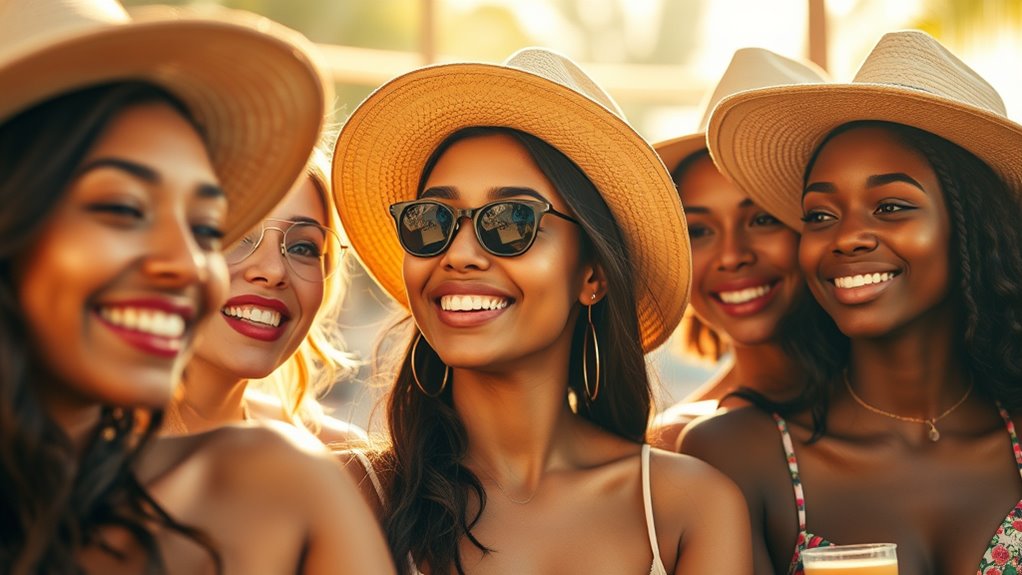
Promoting safer beauty standards requires a multifaceted approach that prioritizes education, regulation, and community involvement. You can support this by engaging in educational programs that inform you about the risks of harmful chemicals in beauty products, and by advocating for transparency through certifications like the EWC Beauty Certification. Regulation efforts, such as the Mercury Out of Cosmetics bill, help guarantee products are safer for everyone. Exposure to body-positive media content can improve your body image and challenge unrealistic standards. Community organizations play a crucial role by providing resources and support, especially for marginalized groups disproportionately affected by toxic products. By staying informed and advocating for policy reforms, you contribute to creating a beauty industry that promotes health, diversity, and safety for all.
Frequently Asked Questions
How Does Childhood Exposure Influence Tanning Habits Later in Life?
Childhood exposure to UV radiation greatly influences your later tanning habits. If you’re exposed early and don’t use sun protection, you’re more likely to develop a preference for tanning and continue risky behaviors. Sunburns as a kid can also increase your skin cancer risk later. By adopting protective habits early, you can break the cycle and reduce the likelihood of unhealthy tanning habits as you grow older.
What Psychological Disorders Are Linked to Compulsive Tanning Behaviors?
You might wonder which psychological disorders connect to compulsive tanning. OCD considerably increases the risk, often driven by anxiety or ritualistic behaviors. Body Dysmorphic Disorder (BDD) leads individuals to tan excessively to fix perceived flaws. Anxiety disorders, like panic or social phobia, also play a role, often as coping mechanisms. Depression and substance use disorders frequently co-occur, influencing tanning as a way to improve mood or self-esteem.
How Do Tanning Attitudes Differ Across Various Cultural or Socioeconomic Groups?
Imagine a tapestry of skin tones, each woven with unique cultural threads. You notice that in Western societies, a sun-kissed glow symbolizes energy and leisure, while in Eastern cultures, pale skin signifies elegance and status. Socioeconomic factors shape access to tanning resources and attitudes, with wealth often linked to lighter skin or bronzed radiance. Your perspective is influenced by these cultural narratives, shaping how you view beauty, health, and social standing across different groups.
Can Interventions Targeting Self-Esteem Effectively Reduce Tanning Frequency?
You might wonder if boosting self-esteem can help reduce tanning. Research shows that targeting self-esteem, especially by challenging the belief that tans boost attractiveness, can help some people cut back. However, it’s not a guaranteed fix, especially for frequent tanners who tie tanning to their social and emotional identity. Combining self-esteem strategies with broader approaches—like promoting alternative confidence sources—tends to work best in encouraging behavior change.
What Role Does Genetic Predisposition Play in Skin Tanning Responses?
Your skin’s response to the sun is like a genetic blueprint, guiding how it reacts to UV rays. If your genes favor burning over tanning, you’re more vulnerable to skin damage and melanoma. Variants in genes like MC1R and AHR/AGR3 act as hidden architects, shaping your tan’s depth and your skin’s resilience. Understanding these genetic cues helps you make smarter choices to protect your skin’s future.
Conclusion
As you consider the allure of that perfect tan, remember it’s more than just skin deep. Behind the glow lie powerful influences and deep-seated beliefs about beauty and confidence. But what if there’s a safer way to achieve that radiant look—or even redefine what beauty truly means? The choice is yours, and the story isn’t over yet. Will you follow the familiar path or forge a new one? The next step could change everything.









